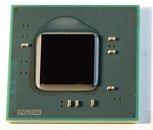Tuesday, March 1st 2011

Intel Intros Atom N570 Dual-Core Processor
Intel today expanded its Atom family of high-efficiency, low-footprint x86 processors, with a new high-speed dual-core model. The Atom N570 released today is clocked at 1.66 GHz, a 166 MHz increase over N550 and its 1.50 GHz speed. The dual-core chip is backed by HyperThreading technology, which gives the OS a total of 4 logical CPUs to work with. Atom N570 features a single-channel, low-latency DDR3 memory controller, with DDR3-667 being the memory speed standard (common DDR3-1066/1333 modules will run at 667 MHz, with lowered latency). The processor also embeds a graphics controller, a PCI-Express root complex, and an L2 cache of 1 MB. One can expect N570 to gradually replace N550 in netbooks.
Source:
Intel

39 Comments on Intel Intros Atom N570 Dual-Core Processor
And everyone saying E350 smashes the Atom. Absolutely not! Have you read the reviews? Do you own these devices? The E350 CPU is not a lot faster. IIRC between 0%-30% depending on application, an average around 15%. And for multithreaded apps, 0% or -ve. It is the same order of magnitude, same ballpark performance, and nothing to get excited about. NOW, the GPU half of the E350 is better than Intel's offering, without a doubt. But so is ION and ION2 that pairs with Atom. And you need to ask yourself what the "Atom machines" are being used for. They certainly are not workstations or games platforms! For Office, productivity, small servers, or NAS-type devices, they are quite fine. In all of these examples who gives a hoot about 3D performance?
Remember: usage scenario. Atom is fine for what it was designed for. Low power terminals, x86 NAS, and netbooks a-la 2009.
I agree for small laptops today the A350 is far better... because netbooks have become laptop replacements and we want more video processing power for flash, basic 3d, etc.
This is little more than a clock rate update.
So, if I change the SO-DIMM by a DDR3-1066 with CAS 7, will it lower the latency proportionally down to something over 4? Will it be automatical?
Or I'll end up, if I don't or can't change timings with a dimm woking at 667 MHz and latency 7 which, of course, will be slower than a native 667 dimm with CAS 5?
Thanks!
I would advise you to NOT worry about it though. CAS timings on memory make very little real world performance difference. On a PURE MEMORY benchmark, you might see 5% difference. But run an application or a game or something "real" and you will see less than 1% if not 0.1%.
So just buy according to your budget, dont pay more for lower CAS timings on an Atom system.
I didn't know that it the cas at different frequencies was specified for a given SO-DIMM.
In fact my worry is not about buying a module with smaller CAS, even if it's more expensive.
I was worried about buying a more expensive 1066 Mhz CAS 7 module when in fact I can get better performance with a (hopefully) cheaper 677 MHz CAS 5 one.
Because... this diverges a bit from the main subject of this thread, but I wonder if a module operating at 677 MHz with CAS 5 is equivalent to one operating at 1066 with CAS 7 and to one operating at 1333 with CAS 9, for example, as my short knowledge about this makes me think that, if an access takes a given number of cycles, you win nothing with a higher frequency if you also need proportionally more cycles for one access. If so, then the speed of a memory module could be roughly calculated as its frequency divided by it's latency in cycles.
Am I too wrong?